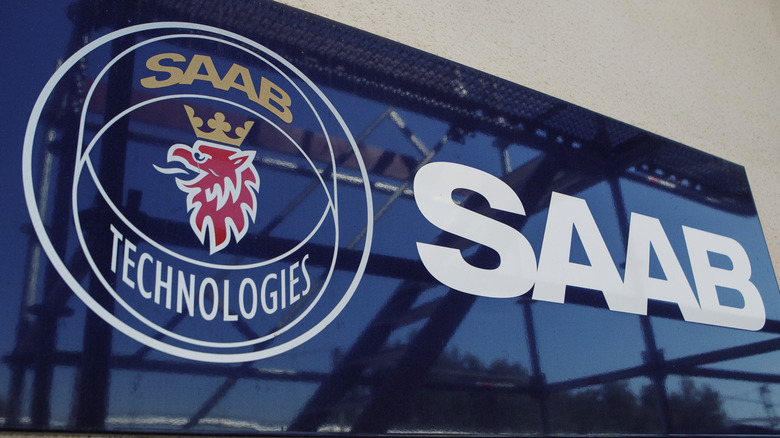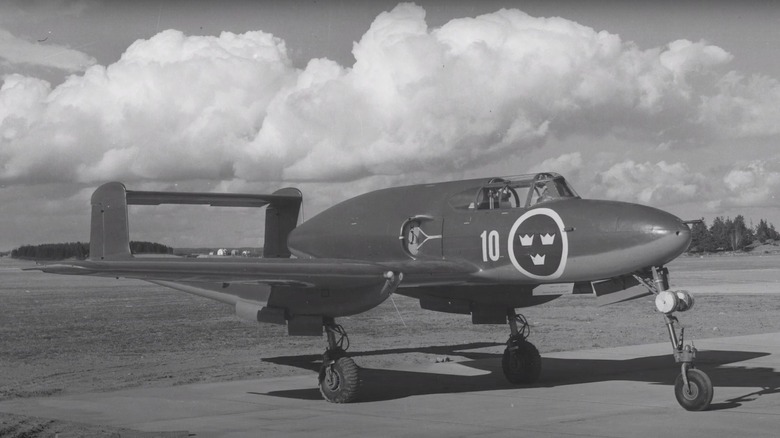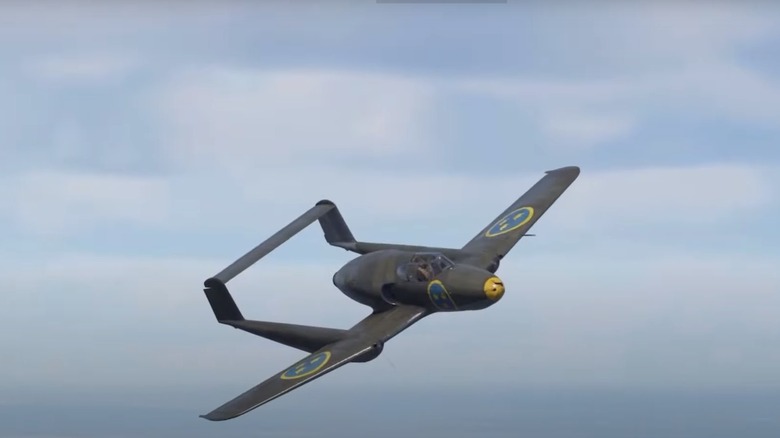All About The '21R': Saab's First Jet-Powered Fighter
When you think of Saab, you probably envision one of their many compact car models, but the company is so much more than your typical automaker. In fact, Saab Automobile was acquired by industry giant General Motors more than twenty years ago and ceased car production in 2011. Fortunately, automobiles are only one of the company's trades, which include aviation, watercraft, information technology, and weapon systems.
The Swedish company Saab surfaced in the years leading up to World War II because the country wanted to develop its own military aircraft. Not only could Swedish defense forces keep an eye on local production, but it also maintained the country's neutral stance that would've been compromised with a foreign partnership.
The military fighter aircraft Saab J21R was adapted from the Saab J21, a piston-propelled plane. The Saab J21R would mark one of few instances where a propeller-driven aircraft was modified with a jet engine while retaining the same frame. The overall look of Saab's fighter jet is a bit odd, with twin tails that attach and propulsion coming directly from the tail. For fans of historical aviation, many of the oldest aircraft that are still in service today are routinely spotted across the modern skies.
Jet propulsion introduced problems in the Saab's design
While the previous propellor-driven model, the Saab J21, featured good competitive performance for its time, once Saab installed a jet engine, issues with the frame came to light. Aerodynamically, Saab's J21R frame wasn't suited for the speeds or demands a jet engine could achieve. Top speed was limited, and the aircraft was difficult to control, which are not qualities you want in a fighter plane.
The outdated frame created drag, and jet engines back in those days were less efficient than modern variants, so the J21R initially had a low range. According to Military Factory, in just 40 minutes of flying, pilots would run through their fuel supply, severely limiting the usefulness of the aircraft. Saab's J21R was not comparable in performance to other jet fighters available at the time.
In fact, after experimenting with more powerful Goblin II and Goblin III turbojet engines capable of up to 3,305 pounds of thrust to no avail, the plane was grounded by 1954. Fortunately, Saab was already hard at work on more advanced models that would provide competitive performance in the air. Military services worldwide have sunk a fortune into their air forces over the years and crafted some of the most expensive military aircraft ever built.
Better suited for attacking ground targets
Since the Saab J21R wasn't maneuverable in the air when facing off against other fighter jets, Sweden discovered it was far more helpful in ground attacks. Fitted with a 1 X 20mm cannon and 4 x 13.2mm heavy machine guns, the J21R was ideal for engaging hostile land-based forces. Saab's first jet fighter pilots also had an advantage in lining up their shots due to the short nose cone.
Later, Swedish forces would equip even more firepower onto the J21R with 8 x 8mm machine guns or rockets to help bombard the enemy from above. The subsonic maximum speed of 497 mph didn't hinder Saab's attack jet because it made it an optimum aircraft for low strafing runs, which supported the soldiers on the ground. The J21R could also carry several armaments, handling up to nearly 10,000 pounds on take-off. Since Saab's jet could handle so much weight, it was able to hold more weapons and would be able to perform more attack runs on the enemy before returning to base.


